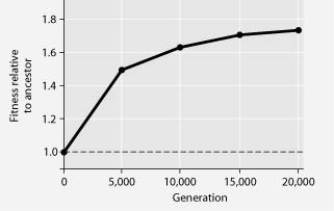Multiple Choice
The following question refers to the figure.
In this eight-year experiment, 12 populations of E. coli, each begun from a single cell, were grown in low-glucose conditions for 20,000 generations. Each culture was introduced to fresh growth medium every 24 hours. Occasionally, samples were removed from the populations, and their fitness in low-glucose conditions was tested against that of members sampled from the ancestral (common ancestor) E. coli population.
E. coli cells typically make most of their ATP by metabolizing glucose. Under the conditions of this experiment, E. coli generation times in the experimental lines and low-glucose conditions should ________.
A) be the same as in the typical environment
B) be faster than in the typical environment
C) be slower than in the typical environment
D) increase over time in the experimental cells
Correct Answer:

Verified
Correct Answer:
Verified
Q9: The following question refers to the figure.<br>In
Q10: Use the following information and graph to
Q13: If all prokaryotes on Earth suddenly vanished,
Q14: Biologists sometimes divide living organisms into two
Q14: The following question refers to the figure.<br>In
Q15: The following table depicts characteristics of
Q30: The thermoacidophile Sulfolobus acidocaldarius lacks peptidoglycan, but
Q36: Use the information in the following paragraph
Q56: Which of the following is least associated
Q62: Genetic variation in bacterial populations cannot result